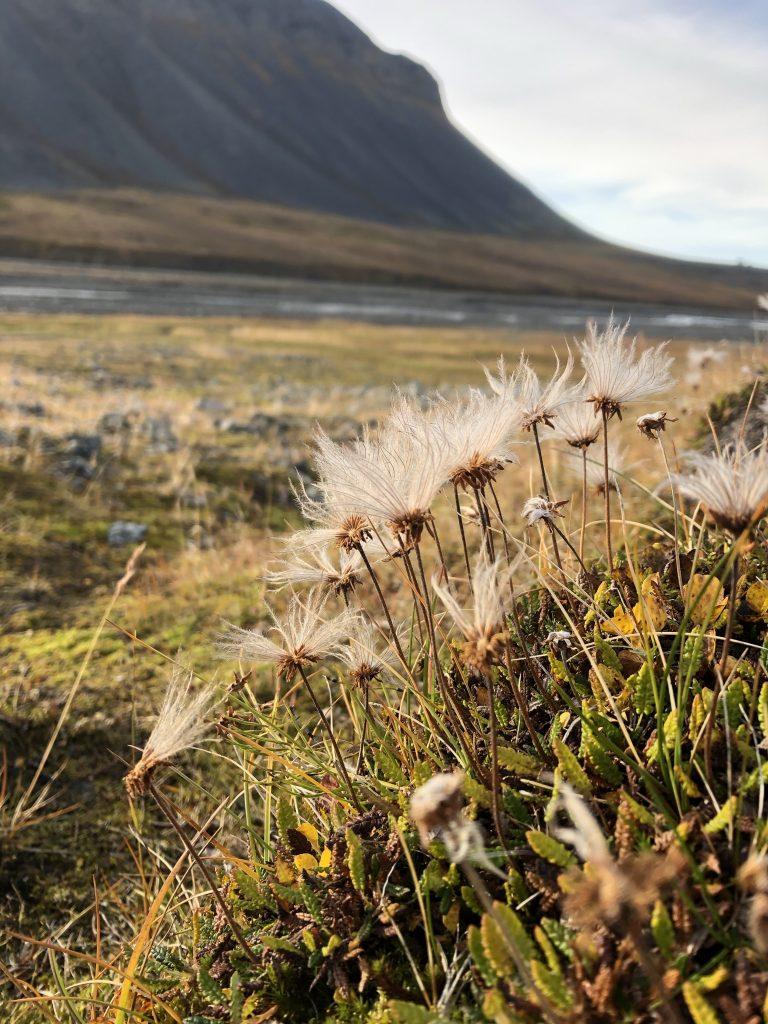Even if an arctic plant manage to produce seeds, or reproduce by other means, very few of the initially produced propagules survive in the end. Dispersal is the first obstacle. Several dispersal vectors aid seed dispersal, and plants can be adapted towards certain vectors. In the Arctic, we find similar dispersal vectors as further south, including wind, water, birds, mammals, sea currents, driftwood, and humans. However, the efficiency of each of them will differ.
Dispersal adaptations
Animals
Few species are adapted towards animal dispersal. The density of terrestrial birds, mammals and humans are low, and fleshy fruits typically adapted to be eaten and dispersed by animals are costly to produce and sensitive to frost. Still, seeds are eaten and spread by the birds and animals present. Interestingly, even foxes spread seeds. A study from Greenland found seeds from 22 species in feces from arctic fox, whereof 19 germinated (Graae et al., 2004).
Wind
Wind is the most important dispersal vector in the Arctic. Wind is always present, and in the late autumn the topography is smoothed out by snow. To blow over smooth surfaces like snow and sea ice is efficient. Adaptations towards wind dispersal include plumed seeds or fruits, like in Dryas, Eriophorum, and Salix; winged seeds, like in Oxyria and Betula; or simply having very small seeds such as in Cassiope (Berg, 1983).
Water
Dispersal by water can also be efficient. Chrysosplenium is adapted towards water dispersal, and their seeds are placed in “splash cups” that accelerate raindrops to disperse seeds (Amador et al., 2013).
Establishment and survival to maturity
Even if an arctic plant manage to produce seeds, or reproduce by other means, very few of the initially produced propagules survive in the end. Dispersal is the first obstacle. Several dispersal vectors aid seed dispersal, and plants can be adapted towards certain vectors. In the Arctic, we find similar dispersal vectors as further south, including wind, water, birds, mammals, sea currents, driftwood, and humans. However, the efficiency of each of them will differ.
Seed or bulbil germination percentage of 87 plant species from Svalbard were tested in lab condition (Alsos et al., 2013). The results showed that many plants have intermediate to high germination percentage, but their germination percentage and seedling survival are strongly reduced in natural conditions (Müller et al., 2011). For those who manage to germinate and survive the first season, it is still many challenges ahead. To allocate resources over several seasons is a good strategy to overcome the challenges related to short growing season, but require survival for a longer time to reach maturity. Upto ten years are not uncommon. Pucciniellia vaginata (High Arctic Canada) need for instance up to 48 years before reaching maturity (Grulke & Bliss, 1988).
Photo: Pernille Bronken Eidesen
Alsos IG, Muller E & Eidesen PB (2013) Germinating seeds or bulbils in 87 of 113 tested Arctic species indicate potential for ex situ seed bank storage. Polar Biology 36: 819-830.
Amador G, Yamada Y, McCurley M & Hu D (2013) Splash-cup plants accelerate raindrops to disperse seeds. Journal of the Royal Society, Interface / the Royal Society 10: 20120880.
Berg RY (1983) Plant distribution as seen from plant dispersal. General prinsiples and basic modes of plan dispersal. Dispersal and distribution,(Kubitzki K, ed.) p.^pp. 13-36. Verlag Paul parley, Hamburg.
Grulke NE & Bliss LC (1988) Comparative Life History Characteristics of Two High Arctic Grasses, Northwest Territories. Ecology 69: 484-496.
Graae B, Pagh S & Bruun H (2004) An Experimental Evaluation of the Arctic Fox (Alopex lagopus) as a Seed Disperser. Arctic Antarctic and Alpine Research – ARCT ANTARCT ALP RES 36: 468-473.
Müller E, Cooper EJ & Alsos IG (2011) Germinability of arctic plants is high in perceived optimal conditions but low in the field. Botany 89: 337-348.









